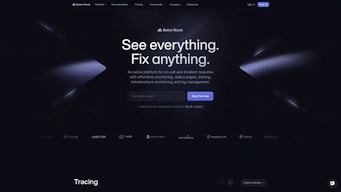

( 166 )
Better Stack Reviews & Product Details
Better Stack lets you see inside any stack, debug any issue, and resolve any incident. Visualize your entire stack, aggregate all your logs into structured data, and query everything like a single database with SQL. Monitor everything from websites to servers. Schedule on-call rotations, get actionable alerts, and resolve incidents faster than ever. Made to fit into your workflow with over 100+ integrations.

| Capabilities |
|
|---|---|
| Segment |
|
| Ease of use |
|
| Deployment | Cloud / SaaS / Web-Based, Mobile Android, Mobile iPad, Mobile iPhone |
| Support | 24/7 (Live rep), Chat, Email/Help Desk, FAQs/Forum, Knowledge Base, Phone Support |
| Training | Documentation, In Person, Live Online, Videos |
| Languages | English |





It has a free plan to use and it's enough for small business. I can monitor 10 websites with 3 region and also I can create a status page with using my subdomain.
The Freelancer plan's price is too high.
Better Uptime monitors my websites for me and informs me when something happened to them.
The focus and depth of the product. Unlike other companies where logging is only a small part of the offering.
It's new software. I had one minor issue, but their support had it fixed within an hour! I wish there was a Winston client, but I may just write one.
They're likely to become my go-to solution for log management - serverless, traditional, everything...
I love Better Uptime's design and ease of use. And when the site crashes, I think it's an excellent feature that they reach you by e-mail, sms or calling. 10/10!
There isn't a feature I don't like, but the live chat (support team) is slow to respond.
Better uptime keeps me aware of crashes on my site. And it helps my team.
I've been using Better Uptime for a while now and have been very impressed. It was very easy to set up and is very easy to use. I tried other similar offerings but settled with Better Uptime for its stability and ease of use.
Nothing really to dislike. I'm only on the free tier, but this covers everything I need. At first, I thought the pricing was a little high, but having used it I can see it would be value for money.
Compared to my previous onsite monitoring system Better Uptime (being off-site) is far more stable and reliable. I've never missed an alert and have very few false positives.
So easy to create a monitor with all the features I needed.
Nothing, this was a no-brainer with simple step-by-step instructions.
Better Uptime allows any webmaster or hosting business to quickly and easily know if your website is up! It also allows for phone calls from Better Uptime to notify you instantly if a site goes off-line.
The free plan is really making good to use!
I wish I can edit the status page but it's already great!
I wanted to have a solution that shows me how my apps are and it's doing the job just right.
Extremely intuitive and easy-to-use interface. Easy-to-implement monitoring with many possibilities. The status page is excellent and allows you to create more than one. Incident management is also very powerful.
Do not allow any more integrations in the free plan.
Centralized incident management and real-time monitoring. Process optimization and improved incident response time.
Has a free tier of service Customizable status page Represents status in a meaningful way Ability to provide updates during issues or even during maintenance Very well designed, kudos to the team Easy setup
There is nothing that I dislike about Better Uptime. It will be very exciting to see the Better Uptime service continue to grow over time and see the features grow and more features added.
It is helping keep track of website uptime. I can compare it against my web hosting to see where issues are, whether it be something I inadvertently caused or something wrong on the web host's end. I wanted to provide transparency to my users about the status of the page, whether it be completely down, degraded performance, or undergoing simple maintenance. The fact that others can report issues too makes it a lot better.
It has an amazing UI, and SMS notifications and it monitors any type of system including SMTP, IMAP, servers and domains with their respective response time. Whenever there is an issue the team is notified. You can also connect a custom domain for the statuspage.
It's a little time-consuming to set up all the monitoring services for the different components and it's not that easy to change the design of the status page that is created,
To use several other software to monitor the throughput, the origin requests health, and the responsiveness of the service. It also provides a centralised bugs management system with tagging options which really helpful.
I like the query engine which helps me find logs eaily
More support for Android/Timber logs will be nice
I can see logs from my android app which is deployed on end user devices.